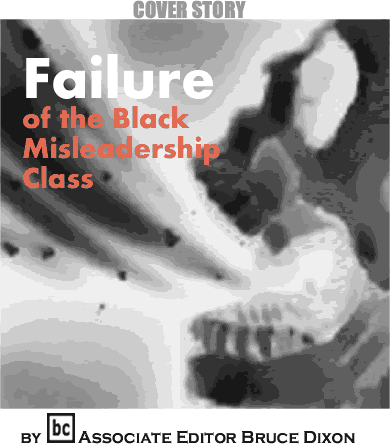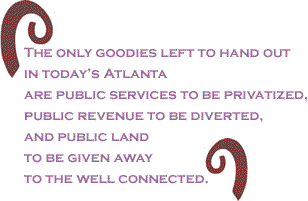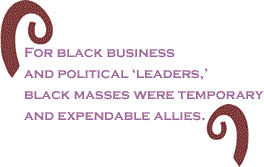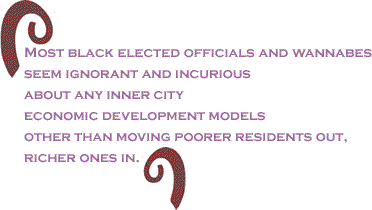
|
|||||||||||||||||||||
 |
|
The cohort of black business people and politicians who pass for African American leadership is at an impasse, and so is the rest of black America. Our leaders have failed to produce economic development models for inner cities and poor black enclaves that benefit the people who live there now. Not only is the black leadership class unable to create jobs at living wages for the hundreds of thousands of black families that desperately need them, they can't even describe to the rest of America how such a thing might be done. The black leadership class dares not acknowledge the acute shortage of low and moderate income housing, or publicly question programs like HOPE VI which exacerbate that shortage. The black leadership class have proven powerless to prevent the nationwide imposition of separate and grossly unequal education, the disastrous application of high-stakes testing and the use of "No Child Left Behind" to discredit and defund public education. African American business and political leaders even lack the political imagination to rally their constituencies against the growth of a racially selective crime control and prison industry that has criminalized an entire generation of black youth, with far-reaching economic and social consequences. With some notable exceptions like Reps. John Conyers, Jesse L. Jackson Jr., Cynthia McKinney and Maxine Waters and others on the national stage, and a modest number of similar local office holders, black elected officials have generally proven unwilling or unable to defend the very democratic openings that made their own emergence on the national scene possible. Rather than leading the fight to preserve the public sector with its disproportionate share of black workers and inherent susceptibility to democratic influence, many black officeholders and appointees have eagerly embraced and sought to profit from privatizations. They have served as key players in the long term diversion of public resources into private hands, and become willing accomplices in the spatial deconcentration and disempowerment of black communities.
Leading the nation in numbers of black millionaires and ruled by black mayors for more than thirty years, the city of Atlanta provides the best example of the failure and duplicity of the black leadership class and its idea of economic development. Contractors Trump Constituents It was 1973. The movements against Jim Crow and for voting rights in the South were still recent memories. The graves of the struggle's martyrs were no longer fresh but the memories of its living participants as well as those of millions of others it touched and transformed were still vivid. So it was that Atlanta's election of Maynard Jackson as the first African American mayor of a large southern city was hailed as a triumph. It was, many of us told ourselves, the latest of many fruits of the long struggle. The freedom movement - at that time only establishment whites called it a "civil rights movement" - had opened the doors of opportunity to a new black business and political class. Maynard Jackson was one of its first representatives, but he would not be its last. In our October 13, 2005 article "Black Mecca: the Death of an Illusion," BC contrasted the performance and priorities of the freedom movement's tree shakers with the black political class of jelly makers that succeeded them.
But black elected officials, as political scientist Jerry Watts pointed out in the November 17, BC cover story "What Use Are Black Mayors," have most often emerged from establishment circles that were never in the "vanguard of the continuing civil rights struggle" or parts of any insurgent political formations. The economic justice agenda of King era prophetic leadership was discarded. The concerns of the new black political and business class were largely limited to its own priorities: voting rights, affirmative action and minority business set-asides. The demand for societal economic justice was replaced by the quest for "community economic development," which usually meant creating black millionaires. The thought was and still is that creating black millionaires helps everybody. Black contractors hire other blacks, spend their money with other blacks, reinvest in black communities, and the rising tide of their prosperity circulates throughout the African American community. With the building of the nation's largest airport, a project which would have gone forth no matter who had been Atlanta's mayor, Maynard Jackson had a unique one-time multibillion dollar jackpot of contracts to award, an environment which provided the best possible test of the theory that empowering black businesses would result in the enrichment of the entire African American community.
Thirty years later, the results are in. The experiment
has failed. It is now indisputably clear that economic development,
as preached, practiced and administered by our African American
business and political elite does not lead to economic justice.
The bankruptcy of the black-business-lifts-all-boats theory is
evident throughout black America, and in The only remaining goodies left to hand out in Shirley Franklin's Atlanta are the few remaining public services that can be privatized, the future tax revenue which can be diverted to favored bankers and middlemen via bond issues, and the land under the city itself, which can be eased into the hands of well-connected developers by a number of means. Strip Mining the Public Sector One of the Clinton administration's chief domestic priorities was something it called "reinventing government." The happy talk was that "reinvention" would introduce competition, "entrepreneurial spirit," and a "customer service ethic" into the functioning of state, federal and local governments. Behind the happy talk, the "reinventing government" initiative was about privatization of a vast array of governmental functions on all levels from food service to fleet maintenance, from purchasing and payroll to prisons. The push for privatization on the part of Democrats was a response to corporate campaign contributors, who aimed to make up for declining rates of corporate profit by cannibalizing the public sector. Corporations that received the contracts got, in many cases, a guaranteed minimum rate of profit, which could be improved upon by lowering wage and benefit levels of the formerly public employees, by making the public pay "user fees" for services and through other means. State and local governments were required, often as a condition for receiving federal funds, to identify which components of their operations would be most attractive to privatizers, and to bid them out. Payroll, vehicle fleet operations, child support enforcement and dozens of the functions of thousands of state, county and municipal governmental units around the country were parceled out to a relative handful of corporations. Needless to say, the corporate beneficiaries of privatization were often direct and indirect campaign contributors to federal, state and local officials.
For the black community, there were many downsides to this wave of privatizations. Due to the public sector's relative lack of racial discrimination, government workforces historically contained more than their share of minorities. Frequently these government workers had achieved union contracts, civil service protection, medical care and defined benefit pensions. For generations, those steady if underpaid government jobs had been a lifeline that helped lift many black families, chunks of whole communities out of poverty and into relative middle class prosperity. Another downside of privatization is that when government functions are taken over by private corporations, elements of their processes and outcomes become private property, and are thus less susceptible to public oversight and democratic influence. For the most part, black business and political leaders either lacked the vision to see what was happening, or simply did not value the stability of working class communities and families whose wages were lowered, whose job security was imperiled, who lost health care, pensions and some of the hard-won political influence over the process of governance which made their own emergence as a black "leadership" class possible. For black business and political "leaders," the black masses were temporary and expendable allies. They revised their speeches to include pro-privatization buzz words like public-private partnership, managed competition, and entrepreneurship, and set about pursuing their more enduring interests, like securing a portion of the contracts for minority vendors, and a share of campaign contributions for themselves. By 1998 in Atlanta, where the black business and political class had installed itself a generation ago, Mayor Bill Campbell did the nation's largest water privatization deal yet, handing over the city's water system for 20 years to a private contractor. For this, Mayor Campbell was awarded a "Best Practice Recognition" by the corporate-funded US Conference of Mayors. But in a pattern that has repeated itself on several continents, the city's water contractor ushered in exorbitant rate increases and failed to deliver. Lots of white and well to do people live in Atlanta, so the failures were big news. Atlanta's water privatization deal unraveled in spectacular public fashion four years later, early in the term of Campbell's successor, current Mayor Shirley Franklin, who was forced to void the contract and hand the water department back to the city of Atlanta. A key document produced by the new mayor's transition team was the Bain Report, early versions of which recommended a long string of city functions to be "marketized" and outsourced "opportunistically," the report said, beginning in 2002, from information technology to garbage collection and vehicle fleet management. Despite public speeches in which Mayor Franklin promised to use the Bain report as "the blueprint" for her administration, the public fiasco that followed Atlanta's disastrous water privatization made more big-ticket giveaways of public resources to well-connected privatizers too politically risky. Atlanta's new mayor would have to find other ways to transfer the scarce public resources of her city to private hands. Public-Private Giveaways: The Atlanta BeltLine Heist TIF stands for Tax Increment Financing. Originally sold to the public as a means of fostering beneficial economic activity in "blighted" or "underdeveloped" areas, TIFs are now legal in forty-seven states and the District of Columbia. Here's how they work: TIF districts are created in areas where local government wants and expects property values to rise as a result of new construction, rehab and ongoing economic activity. When property values go up as a result of such activity, a local government normally expects to collect and keep more property taxes which it can use for things like roads, schools, sewers, infrastructure, police and fire protection. But in a TIF district local government freezes the amount of property tax revenue it keeps to use for schools, roads, sewers, etc. at pre-development levels for 20, 23, or 25 years depending on local regulations. The property tax revenue collected within a TIF district in excess of pre-development tax levels goes into a special fund which can only be spent on improvements inside the TIF district. A spending authority representing property owners within the TIF district is usually appointed to spend the set-aside property taxes. In order to get its hands on the two decades of "excess" property tax revenues up front the spending authority uses a bond issue to borrow the money, often at ruinous interest rates that obligate the bonding authority to repay better than two dollars for every one borrowed.
Thus having your factory, home, business or mall within a TIF district means a big chunk of your property tax bill is spent right outside your door on stuff you might otherwise have had to pay for yourself, instead of going to help pay your fair share for roads, sewers, schools, fire and police protection like other local property taxpayers who don't have friends in high places. Nationwide, TIF districts have become lucrative tax breaks for rich developers and favored corporations, which often demand them from local officials as a condition of relocating into, or not relocating out of a city or town. In Georgia, TIFs are called TADs, or Tax Allocation Districts. The Atlanta BeltLine is the local name for a deceptively marketed multibillion dollar bond and real estate scam surreptitiously pushed into law by Mayor Shirley Franklin in the closing weeks of 2005. According to the rosy and utterly misleading publicly funded and developer-inspired propaganda which has been the only information to appear in the city's media, the BeltLine is an innovative, forward-looking, environmentally friendly, smart-growth initiative for the 22 mile loop of abandoned and underutilized rail right of way encircling most of the city. The BeltLine is supposed to build tens of thousands of new residential units around the ring, interspersed with new retail and commercial development, along with hundreds of acres of new parkland with plenty of trails for hiking and biking. The whole thing is to be tied together with a light rail or trolley system, which will supposedly help alleviate Atlanta's longest-in-the-nation commutes. A relatively small portion of the housing will be "workforce housing," the current code word for affordable housing, but only if sufficient funds can be found for this purpose. Its backers absurdly claim the BeltLine will create over 40,000 temporary and 30,000 permanent new jobs, and be the centerpiece for the city's development in the new century. The facts are rather different. The BeltLine is a very large TIF or TAD, as Georgia law calls them. Its Tax Allocation District creates an extremely lucrative 23 year property tax break for the rich along the 22 mile loop encircling Atlanta's inner city. Atlanta's black mayor, along with its mostly white media and business elite wanted the BeltLine rushed into law before the end of 2005 so as to freeze the amount of tax revenue retained by local government and maximize the size of the tax break for well-connected developers and speculators. To enact the BeltLine into law on their timetable, the city's black mayor and wealthy developers needed quick approval of the BeltLine from three elected local bodies: Atlanta's school board, its city council and the Fulton County Commission. But why would black Atlanta knowingly approve the diversion of billions of dollars over 23 years from its public schools, from its public health care systems and its ailing infrastructure to subsidize retail and housing for the well-to-do in places that developers were already anxious to build in, with or without tax breaks? What if there were informed public questions? What if there was an actual debate? It wasn't as though developers anxious to build housing for the urban gentry could threaten to take their upscale condos to Nashville or Birmingham if they didn't get fat public subsidies and tax breaks. There is only one inner city in each metro area. Atlanta's black mayor and its mostly white business elite could not afford public knowledge, wide understanding or informed discussion about how and for whom the city's economic development decisions were made. For the BeltLine development scam to be enacted into law, Atlanta's black mayor and her developer allies needed to squelch public discussion of its impact on the affordability of housing in existing African American neighborhoods. They wanted no public talk in print or broadcast media about how much money the BeltLine tax break might take away from Atlanta's cash starved public schools, and other vital services in Fulton County. They desired that the cost of repaying the BeltLine loans remain obscure. They sought to avoid scrutiny of the BeltLine's ridiculous job creation forecasts, or comparisons with the job creation lies told to get previous TADs. They wanted no inconvenient public questions about the wisdom of subsidizing new retail space, which often simply moves low-wage, no-benefit jobs a short distance up the street instead of enriching communities. Thanks to the nationwide corporate media lockdown of local news and public affairs, they got exactly what they wanted. In Atlanta, as in every media market, local news coverage that tells citizens what they need to know to be effective citizens is virtually nonexistent. In a low-turnout election the day after Atlanta's city council passed the BeltLine proposal, Shirley Franklin was re-elected mayor with a Saddam-like total of 93% of votes cast. But it was an election in which virtually no local broadcast or print media covered the campaigns for mayor, for city council or for school board. It was one in which the Atlanta Journal-Constitution, along with its half dozen associated radio and TV stations endorsed nobody, though the AJC did remember to endorse candidates in that same day's election for mayor and city council in Sandy Springs, a wealthy all-white enclave that finally cut itself loose from Fulton County. New economic development models that benefit black communities can only come from new conversations in those communities. But such conversations have nowhere to take place in cities like today's Atlanta, where broadcast and print media have all but closed the public spaces for intra-community discussion. Atlanta's corporate media have worked to keep development decisions in back rooms and behind closed doors, insulated from public knowledge or input. At the same time that local media refused to ask questions about the impending BeltLine heist, and pointedly ignored election campaigns for city office, print and broadcast outlets were awash in laudatory coverage of its mayor. The fact that Franklin was named the world's ninth best mayor by one business-related international organization was news for days, as was TIME magazine's naming her "Restorer of Faith" and the Kennedy Foundation Library granting her its 2005 Profiles In Courage award for her "principled and bipartisan leadership." With the exception of a single AM station with less than half a percent of metro listeners, Atlanta's black media performed no better than the rest. And with no heat from the black masses, what indeed can be expected from our black leadership class? Mayor Franklin likes to say that the BeltLine project will define Atlanta for generations to come. But whose Atlanta will it be? HOPE VI and the Emptying Out of Chocolate City If poverty and a lack of decent housing are problems, what are the solutions? To educate, train and create opportunities for the poor? To rehabilitate and rebuild affordable housing? Or simply to demolish the housing and disperse the people? Since the 1970's across Democratic and Republican administrations alike, HUD has consistently pursued a policy of demolition, dispersal and deconcentration of poor and black neighborhoods. At first, the emphasis was on enabling some families who wanted to leave to voluntarily relocate. But with the 1992 inauguration of the cynically misnamed HOPE VI (Housing Opportunities for People Everywhere) program, federal policies shifted their emphasis from voluntary transfer to wholesale demolition and rebuilding of neighborhoods.
We are aware of no Hope VI demolition project in which new units been made available to all former residents of public housing. Most often, large proportions of the previous population are abandoned to the private market. In cities large and small across the nation, prominent representatives of the African American business and political leadership class have been at the forefront of this process. And as always, Atlanta has shown the way. Under the stewardship of Atlanta's four successive black mayors, its chocolate inner city is emptying out. As Georgia State Representative and Clark Atlanta University professor Bob Holmes (D-61) observes in the preface to The Status of Black Atlanta 2005:
If Rep. Holmes sees a justice problem or an equity problem, he fails to mention it. What he and a big slice Atlanta's black leadership class and its wannabes do see as a problem is the possibility that Shirley Franklin may be Atlanta's last black mayor. For most black Atlantans however, it's no big deal. Economic Development and the Black Leadership Class When the economic development schemes of the black leadership class are not fraudulent they are often downright foolish. Like the white political and business class whom they ape, most black elected officials and wannabes seem ignorant and incurious about any inner city economic development models other than moving poorer residents out, richer ones in, and building brand new retail and commercial space. Their simultaneous detachment from the real world and abysmal lack of imagination is graphically evident in Atlanta's "New Century Economic Development Plan." For example, the document names "transportation, logistics and distribution" as the industrial sector with the greatest local job growth potential, piggybacking on the existence of Atlanta's vast Hartsfield-Jackson airport, followed by the "hotel, tourism and entertainment" sector. One wonders if any of Atlanta's local corporate visionaries or their black lackeys have heard of Peak Oil, or if they comprehend, even dimly, the far-reaching changes local economies will soon face in the coming era of continually rising oil prices. Passenger airlines and air cargo depend on jet fuel, for which there is no substitute, and truck transport is similarly reliant on diesel. Job growth in the hospitality industry too, is contingent upon a continually increasing number of visitors burning ever larger amounts of increasingly expensive fuel to drive or fly into Atlanta for years to come, an uncertain prospect to say the least. In the section dealing with economic development goals for underserved areas, the first priority is aiding the creation of retail "opportunities in grocery, apparel, mass merchant, pharmacy and fast food sectors…."
Can these geniuses really believe that having more places to shop will make poor people wealthier? Real experts in community economic development like Greg Leroy of Good Jobs First vehemently disagree. On pages 140-141 of The Great American Jobs Scam LeRoy puts this mistaken notion to rest:
What We Don't See Most of our black leadership class is unable to think outside the boxes of privatization, spatial deconcentration and public subsidies for gentrification imposed on them by corporate media and the need for campaign contributions. Hence we are not seeing them come up with economic development plans in Atlanta or anywhere else that would keep thousands of black families out of bankruptcy. We don't see enough of them come out for the reinstatement of usury laws and the curtailment of payday and other predatory lending. We don't see many of the black leadership class taking the hint from GM execs - both GM and Ford have announced the closings of their Atlanta plants - that the adoption of universal pensions and health care would ease their competitive disadvantage. Economic empowerment of the people who reside in inner cities and other black communities today demands a combination of political will, visionary thinking, and organizing acumen. It requires the resurrection of a democratic media space inside black communities where spirited intra-community discussion can take place, and in which leadership can be held to account. The business class has failed. Let's move them out of the way. You can reach BC Associate Editor Bruce Dixon via e-Mail at [email protected]. |
|
| Home | |
Your comments are always welcome. Visit the Contact Us page to send e-Mail or Feedback or Click here to send e-Mail to [email protected] e-Mail re-print notice
If you send us an e-Mail message we may publish all or part of it, unless you tell us it is not for publication. You may also request that we withhold your name. Thank you very much for your readership. |
|
| February 9, 2006 Issue 170 |
||||||||||||||
|
||||||||||||||
|
||||||||||||||
| Printer Friendly Version in Plain Text or PDF format. Download free Adobe Reader. | ||||||||||||||
 |
||||||||||||||
 |
||||||||||||||
 |
||||||||||||||
| |
||||||||||||||
| |
||||||||||||||


































